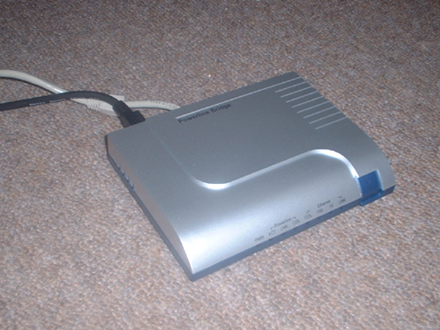Test 3 - Excellent Operation
Scenario 3.
Heavily overloaded plug socket to bridge on same power circuit
Signal rated as excellent 14Mbps.
SiSoftware Sandra
Host
Name : CAROL
IP Address : 192.168.123.140
Benchmark Breakdown
Average Latency : 3ms
Min/Max Latency : 3 / 5ms
Transfer Rate : 682kB/s
LanMark FileCopy: Version 8.2.197 2000-2001
Comments:
--Test Recorded on 02/05/2003 at 21:06:27
Test File Initial Size=[3.94] Mbytes/s
Test File Final Size=[3.94] Mbytes/s
Number Of Passes=[3]
--Send-- --Receive--
Min: 1.83 - 2.23 --MBits/s
Max: 2.28 - 2.29 --MBits/s
Avg: 2.12 - 2.27 --MBits/s
Pass Number1: Send =1.83 Receive =2.28 -MBits/s
Pass Number2: Send =2.26 Receive =2.29 -MBits/s
Pass Number3: Send =2.28 Receive =2.23 -MBits/s
--Test Finished on 02/05/2003 at 21:06:27
--Errors on Send=[0]
--Errors on Receive=[0]
----LanMark Pro: Layer 1 Software, 2000-2001 all rights reserved.----
Well this has just blown me away really. My thoughts were that the overloaded plug this end was causing a huge amount of interference. Even though it does have an effect its quite clear from this set of results that the technology if run on the same power circuit can overcome such problems.
USB adapters for anything can be really simple to use but they do have performance drawbacks. Without another HomePlug adapter to compare with, I cannot be sure if the saturation of performance is due to the technology, or the USB device. If we use Sandra we get a 5.4Mbps figure for transfer, however at a sustained transfer rate we experience just over 2Mbps. I am sure a higher data rate could be achieved if I had the use of an Ethernet adapter instead then the data rates would be higher in this case due to the signal being at a maximum. i.e. the Universal Serial Bus (version 1.1) is probably the bottleneck as I have spotted some Ethernet versions (not by the same company but by Siemens) getting between 4.6 and 5.6 Mbps (reference http://www.practicallynetworked.com/review.asp?pid=508).
Never-the-less a good speed even compared to wireless and the added advantage of a low latency (3ms). Could be used for light file sharing, web browsing, and can easily cope with any gaming that could be laid on.

The bridge working on the same power circuit
